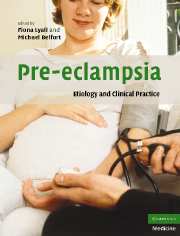Book contents
- Frontmatter
- Contents
- List of contributors
- Preface
- Part I Basic science
- Part II Clinical Practice
- 17 Classification and diagnosis of pre-eclampsia
- 18 Measuring blood pressure in pregnancy and pre-eclampsia
- 19 Immune maladaptation in the etiology of pre-eclampsia; an updated epidemiological perspective
- 20 Genetics of pre-eclampsia and counseling the patient who developed pre-eclampsia
- 21 Thrombophilias and pre-eclampsia
- 22 Medical illness and the risk of pre-eclampsia
- 23 The kidney and pre-eclampsia
- 24 Management of mild pre-eclampsia
- 25 Management of severe pre-eclampsia
- 26 The differential diagnosis of pre-eclampsia and eclampsia
- 27 Complications of pre-eclampsia
- 28 Central nervous system findings in pre-eclampsia and eclampsia
- 29 Pathogenesis and treatment of eclampsia
- 30 Anesthesia for the pre-eclamptic patient
- 31 Critical care management of severe pre-eclampsia
- 32 The role of maternal and fetal Doppler in pre-eclampsia
- 33 Pregnancy-induced hypertension – the effects on the newborn
- 34 Medico-legal implications of the diagnosis of pre-eclampsia
- Subject index
- References
28 - Central nervous system findings in pre-eclampsia and eclampsia
from Part II - Clinical Practice
Published online by Cambridge University Press: 03 September 2009
- Frontmatter
- Contents
- List of contributors
- Preface
- Part I Basic science
- Part II Clinical Practice
- 17 Classification and diagnosis of pre-eclampsia
- 18 Measuring blood pressure in pregnancy and pre-eclampsia
- 19 Immune maladaptation in the etiology of pre-eclampsia; an updated epidemiological perspective
- 20 Genetics of pre-eclampsia and counseling the patient who developed pre-eclampsia
- 21 Thrombophilias and pre-eclampsia
- 22 Medical illness and the risk of pre-eclampsia
- 23 The kidney and pre-eclampsia
- 24 Management of mild pre-eclampsia
- 25 Management of severe pre-eclampsia
- 26 The differential diagnosis of pre-eclampsia and eclampsia
- 27 Complications of pre-eclampsia
- 28 Central nervous system findings in pre-eclampsia and eclampsia
- 29 Pathogenesis and treatment of eclampsia
- 30 Anesthesia for the pre-eclamptic patient
- 31 Critical care management of severe pre-eclampsia
- 32 The role of maternal and fetal Doppler in pre-eclampsia
- 33 Pregnancy-induced hypertension – the effects on the newborn
- 34 Medico-legal implications of the diagnosis of pre-eclampsia
- Subject index
- References
Summary
Introduction
Eclampsia is one of the most severe forms of central nervous system (CNS) involvement in the pre-eclampsia syndrome. Although pre-eclampsia has been known to be a multisystem disorder for over 100 years, much of the pathophysiology, including its molecular manifestations, has only come to light in the past 20 years. This is exemplified by the fact that the prominent causative role of endothelial activation has only been recently appreciated (Redman et al., 1999; Roberts and Redman, 1993; Roberts et al., 1989; Taylor and Roberts, 1999). Currently, the CNS findings in eclampsia can be grouped in two ways: (1) Cerebral blood flow changes associated with gestational hypertension resulting in either hyperperfusion or hypoperfusion, either of which can cause edema and ischemia. (2) Characteristic anatomical lesions documented with either computed-tomographic (CT) scanning or magnetic resonance imaging (MRI) with diffusion-weighted techniques (Brown et al., 1988; Cunningham and Twickler, 2000; Dahmus et al., 1992; Digre et al., 1993; Hauser et al., 1988; Morriss et al., 1997; Port et al., 1998; Schwartz et al., 1992, 2000; Zeeman et al., 2004). These groupings are obviously artificial and there is a large amount of overlap. Specifically, endothelial injury and subsequent leakage of plasma from the intravascular compartment may be associated with manifestations of both functional flow abnormalities and discreet anatomical lesions. In our current understanding of the vascular involvement of the brain in eclampsia, we assume that the cerebral blood vessels are directly involved – in a similar fashion to the peripheral circulation in pre-eclampsia (Hankins et al., 1984).
- Type
- Chapter
- Information
- Pre-eclampsiaEtiology and Clinical Practice, pp. 424 - 436Publisher: Cambridge University PressPrint publication year: 2007



